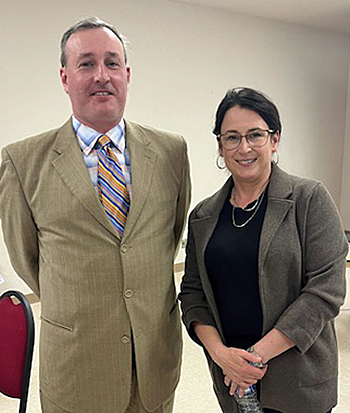 |
| Nathan Origer and Stephanie Wells |
The event at the Knights of Columbus hall, Winamac, drew over 70 persons, including state and local elected officials and business and organizational leaders. A catered dinner was served, followed by the speakers.
Origer, in his annual “State of the County Economy” address, talked on a theme of building "new life" in Pulaski County while keeping in touch with its roots. (The full transcript of Origer’s address appears at the end of this article.)
Keynote speaker Stephanie Wells, in addition to her position at IFPI, is the founder of Wells Strategy + Solutions, which provides clients with assistance on workforce development, economic development, policy solutions, research, and data analysis, along with logic and data modeling. Previously she was vice president of Workforce Development for the Indiana Manufacturers Association.
She discussed the $2 billion budget shortfall Indiana faces at the end of the legislative session, attributed to federal tariffs and resulting economic uncertainty. Wells added that President Trump's tariffs will have a disproportionate impact on Indiana, particularly in the state's manufacturing sector. The legislature's resulting budget revisions to offset the shortfall included a hike in the cigarette tax, but also many across-the-board cuts which Wells said will fall heavily on public schools and public health funding.
Regarding education issues, Wells noted this year's legislative session included discussion on offering students more work experiences and apprenticeships.
The General Assembly did make some cuts to individual income taxes and some property taxes, Wells reported. But again these measures will have consequences to school, health and county government funding, including economic development funding. Wells also addressed some of the energy policy measures that were discussed in this year's state legislative session.
In addition, she pointed out that in federal fiscal year 2024, Indiana received over $177 billion in federal funding. This represents fully one-third of the state's gross domestic product, according to the Indiana Fiscal Policy Institute.
2025 State of the Pulaski County Economy
By Nathan P. Origer, Executive Director
Pulaski County Community Development Commission
As some of you may be aware, during the spring, I moonlight as a color commentator for WKVI (radio), joining Mitch Columbe in press boxes across the area as young men and women take to the diamond. For a number of reasons, I’m doing only three games this year, all softball; fortuitously and, it turns out, fortunately, my first appearance on the air didn’t happen until this past Thursday, just a few short days before tonight’s event, when the Winamac Warriors hosted the West Central Trojans in cross-county action. East beat West pretty handily, although the scoreboard made the game look more gruesome than it was actually played.
During our pre-game conversation, I noted that I expected it to be a really competitive faceoff, as both squads entered the match coming off of impressive win streaks: there was a lot of momentum behind both lineups. Alas, only one could continue its streak.
In the wake of the game, I reflected on how, in some ways, these two Pulaski County teams both represented a sort of microcosm of the community: we have so much momentum behind us right now, and, if we capitalize on it effectively, like the Warriors did, the next several years could be truly transformative. Unlike those young ladies on Thursday night, our momentum isn’t on a crash course with someone else’s: the only way ours fizzles is if we defeat ourselves.
This talk is billed as the State of the County Economy address, but every year, without fail, I feel a bit fraudulent when I give it: it always encompasses so much more. A disciplined person might rein it in, but my real job description has expanded so far beyond the written document, and I believe — if you’ll forgive the jargon — not only that economic development doesn’t exist as a silo and is interwoven with quality-of-life and quality-of-place initiatives, but also that this more broadly conceived community development isn’t an island, but is connected to everything from the local government’s fiscal health to historic preservation to the attitude that our community and its institutions display toward issues like mental health and substance abuse.
When I gave last year’s talk, Tonn & Blank had not yet stepped foot onto the courthouse property; today, we are in the homestretch of this massive rehabilitation of our historically significant, primary government building; the basement no longer looks or smells like a swampy dungeon, chunks of plaster no longer dangle precariously from ceilings, the windows have been repaired — replaced where necessary — and are receiving their first fresh coat of paint ever. A.D.A. compliance is a real thing, and we’ll now be able to centralize more of our operations while no longer holding public meetings at our highway garage, our elected and appointed officials seated at plastic folding tables.
We currently appear to be a little ahead of schedule and on budget; the interest that we’ve generated by investing some of our bond proceeds will leave the county with upwards of $200,000 to make smaller, necessary investments in other facilities. And, as much as I enjoy the bit of isolation that having my office in the Winamac Municipal Utilities Complex affords me, I’m looking forward to having windows that I can open on a nice spring day; 14 years and 11 days without fresh air have been more than enough, so project completion can’t come soon enough. I can’t speak for the elected officials who will have to make these decisions, and we’re certainly carrying a substantial amount of debt, but I remain hopeful that the completion of this massive renewal of our courthouse will catalyze further facilities improvements to create better quarters for employees and improve operational efficiency and effectiveness.
County enjoys financial health
I spoke on this matter in detail last year, so I won’t spend much time addressing it, but it’s worth noting that the county continues to enjoy the benefits of the council’s efforts in 2019 and 2020 to address our looming fiscal crisis. Pulaski County closed the books on 2024 about $1.66-million ahead of end-2023 and about $10.44-million ahead of where we were at the end of 2019. (This latter amount drops to about $8.68-million if we exclude our remaining COVID-relief balance.)
Like most taxing units in the state, we have received a forecast of reduced revenues in 2026 and 2027 attributable to Senate Enrolled Act 1; fortunately, our cumulative losses over the two-year period are expected to stay under $500,000, and, more importantly, over the 2026–2028 triennium, we are actually slated to see an increase of more than $800,000 over where we would have been without the passage of this law. I’m not going to pretend that I understand the mechanics behind these calculations, but am grateful that we can look forward to a really good 2028 after two modestly slower years.
Adding to this sustained financial health is the revenue we’re receiving from solar projects. Before the first commercial panel has even been installed in Pulaski County, we’re sitting on about $675,000 in unrestricted economic-development payments, late fees, and other considerations. Over the coming years, the millions of dollars that these projects will generate just in economic-development payments will give the county the flexibility to reduce debt-service property-tax rates; to sustain wage increases currently funded by ARPA money; to ensure adequate maintenance of our newly remodeled courthouse; to increase our interest-generating savings balances; and to invest in efforts to improve quality of life, place, and opportunity — the chance to invest in our future instead of just treading water. Imagine that.
Especially with Sen. Charbonneau and Rep. Culp in the room, I’d be remiss not to mention the 11th-hour efforts made by them and others to eliminate the removal of our Superior Court from House Bill 1144. We could probably discuss the loss of the court, per se, for hours with people making good-faith arguments for and against it, but the issue is about so much more than just the day-to-day business of thefts, batteries, and everything else that Judge (Crystal) Kocher hears: it’s about the programs and positions she has created with a goal of reducing recidivism, helping offenders to get their lives on track, and, ultimately, saving the county costs related to incarceration and making that many more people available to fill jobs that our employers are creating.
BraunAbility, Shadowbriar upgrade
Speaking of jobs, allegedly, this is our Economic Development Summit, this is the State of the County Economy address, and I am the economic development director, so I suppose I should talk about community and economic development, too, and not just the general operations of our local government.
At last year’s event, I highlighted Plymouth Tube’s 100th anniversary; several months later, the company that the Van Pelts brought to Winamac in 1962 packed its bags and left Pulaski County in the rearview. What a fantastic thing to happen to our community! Truly. We lucked out. Last summer, the company shuttered its facility in West Monroe, Louisiana; an industrial-focused private-equity firm stepped in to acquire and to rebrand our local facility, and we should all be grateful that Shadowbriar intervened.
Wisely, Shadowbriar and the steel-industry veteran whom they brought in as president of Crossroads Seamless USA kept some of the existing leadership team in place; long-time Tube veteran Mike Baxter now serves as the company’s V.P. of operations, running the local campus.
I sat down with Mike late last year, and he shared something interesting with me. He grew up in Cass County and knew nothing about the company when he applied to work here in the mid-1990s; he interpreted the name as suggesting that they made inner tubes for tires. But he needed a job, saw an ad, and drove to Winamac.
He arrived more than an hour early, and there was already a long line out the door. His hopes evaporated, but he managed to secure employment, starting under someone whom many of us know, E.D.C. president and C.D.C. member Al Breyfogle. He left the company for several years before returning, first to one of their other locations and then back to Winamac, working for the company for close to two decades before last year’s sale.
Mike told me that, as his story shows, the manufacturing campus on the north side of State Road 14 at the west edge of town was once the place to work — and his goal is to make this true again. Already, the company and U.A.W. Local 1448 have agreed to a new, three-year contract. I’m grateful for the decades that Plymouth Tube spent in our community, but the time had come for change, and everyone’s better off that it happened the way it did.
Of course, Crossroads Seamless is across the road from BraunAbility; I presume that you’ve found a very cozy space for yourself next door to some worms under a rock if you haven’t heard that Braun just announced a $3.8-million investment in Winamac, a project that will create up to 20 new jobs and provide upskilling training to existing employees. This is on top of all of the improvements that the company has made in recent years, including a massive office overhaul.
As the official press release explained, this project “also paves the way for … future projects … related to design engineering, advanced manufacturing, and ... pre-production”. To think that this all started with a young man who just wanted to be able to get to work and around town and saw a way to turn his struggles into a livelihood and life-changing help for others facing mobility issues. I’ve had a handful of meetings with the company in recent months and am excited and honored to continue working with them to support their ongoing commitment to this community.
The growth that we expect to see on the west side of Winamac will be complementing an already-healthy local employment picture. In March 2024, we had a respectable unemployment rate of 3.7%, with 244 members of a 6,546-person labor force out of work and actively seeking new jobs. Fast forward to last month, and labor-force participation has climbed by 3.8%, while the unemployment rate had dropped to 3.1% — only 209 unemployed members of a labor force of 6,795. These numbers vary from month to month, and our March-2025 total is, admittedly, a hair below our 2024 annual average, but we remain healthy.
Economic Development opportunities expand
I can’t talk about the great things on the horizon and not mention what’s happening in economic development at the regional level. A few years ago, colleagues from several neighboring counties and I undertook the creation of a regional agricultural economic-development strategy; backed by State READI 1.0 funds funneled through the wonderful Northwest Indiana Forum, we have been diligently working with consultants to implement this plan.
A couple of other counties have seen more early successes than we have, but our consultants have been connecting with some of our farmers’-market growers, and we’ll continue to devote resources to facilitating new opportunities for local growers of all sizes and products, connecting our farms with our forks, and searching for ways to create added value for our agricultural sector.
One of the ways in which we hope to do this is by using some of the aforementioned READI dollars to provide the initial funding for a new position at KIRPC, the Monon-based regional planning commission that has been responsible for writing most of the successful grant applications that have funneled federal funds to Pulaski County’s infrastructure systems and development plans. (KIRPC is also responsible for giving me my first job in this field, so blame them if you’re tired of me.) Long-term, we see this position filling dual roles, serving as a point person for supporting our regional agricultural economic-development efforts while also expanding KIRPC’s capacity for grant writing and supporting other regional efforts.
Last year, also with READI funds, we had consultants develop a regional rural-entrepreneurship plan for Jasper, Newton, Pulaski, and Starke counties, as well as the southern, rural parts of Lake, LaPorte and Porter.
Already, we’re able to connect entrepreneurs with the Small Business Development Center. We have our own Revolving Loan Fund, which has supported the growth not only of our caterer’s business, but Tippy’s, Clear Decision Filtration, Mina’s Market, the Casey Williams Company, what has since become Healey’s Home Center, and more.
Pulaski County is served by the Valparaiso-based Regional Development Company, which connects Northwest-Indiana small businesses with the S.B.A’s fantastic 504 lending program. I’d be out of line to divulge details before the grand reveal in June, but I recently agreed to serve as the board secretary for a new regionally focused entity that the R.D.C. has established to create even more financing options.
We have all of these resourced and, yet, we can do more. As we dive into implementing this new regional plan, we’ll also be looking at how we can distill this regional vision down to the local level to provide us guidance as we seek to support local start-ups and smaller existing businesses better than ever.
The 800-pound gorilla
With all of this talk about job creation and efforts to support business expansion and entrepreneurship, we need to talk about the 800-pound gorilla in the room.
Perhaps the biggest concern a lot of us have long had, one that affects the labor force’s ability to fill open positions and so many other things, is our declining population. From the 2010 to the 2020 Census, Pulaski County lost 888 residents, about 89 per year.
From July 2020 to July 2024, we are estimated to have lost 99 people, about 25 per year. We’d all like to reverse the trend, but cutting attrition by 72 percent is a pretty good start, and, if we capitalize on our momentum, we might be able to continue this improvement.
Of course, all of the new job creation in the world only does so much to strengthen our local economy if these positions are filled by non-residents, which should keep us thinking about that population-loss concern. A lot of factors affect this issue, and sometimes it’s not the public sector’s role to address those concerns, but, sometimes there is a place for government to help, pace President Reagan’s famous quip.
Last year, I shepherded a county loan to assist with the development of Willow Creek Villas, a low-income–housing–tax-credit complex in Winamac and the first housing development in Pulaski County in 15–20 years. The county’s share of the project cost is minimal, but provided evidence of local partnership that the state needed to see to support this project.
While these apartments will have income-based eligibility limitations, they will help to open up the local housing market, provide comfortable abodes to residents who will likely include entry-level workers as well as fixed-income seniors, and add buildings to our community designed to complement the historic charm of many Winamac single-family homes.
Sullivan Development’s contractors are making impressive progress on these 34 units, and we should expect to see them host an open house late in the third quarter or early in the fourth.
At the same time, we’re working on connecting all of the dots to move forward with a second housing development, one focused primarily on workforce housing — market-rate units geared and priced primarily toward the men and women who fill the jobs that our manufacturers are creating. This project was originally born out of the efforts of the Housing Taskforce that emerged out of the Community Foundation’s Aspirations-in-Action endeavor, and, if all of the pieces fall into place, we’ll have $1 million in State READI 2.0 funds to leverage for this project.
I admit that I have done a terrible job of marketing the opportunity to residents and bankers alike, but Pulaski County is also participating in Club 720’s Hoosier Homes down-payment–assistance program, which helps first-time homebuyers to soften the upfront burden of achieving the American Dream.
Another, recently added part of the American Dream is having high-speed internet at home, and another effort that originated with the Aspirations-in-Action program is our Broadband Taskforce.
Chairman Kurt Dickey, Community Foundation Executive Director Leeann Wright and I have worked to support providers whose missions we have felt align with Pulaski County’s needs as they have sought grant funding to bring connectivity to unserved parts of the county.
Between Leeann’s efforts and the grant we received from OCRA through our partners at KIRPC, we have access to $100,000 to develop and to build upon a strategic plan for the best-practices–based buildout of high-speed internet across all 432 or so square miles of Pulaski County — or at least those not already served by fiber.
Thanks to Doral’s tech requirements as they build the Mammoth Solar – Central project, our great local partners at Lightstream are delivering fiber service to another 150 households west and northwest of Winamac, while Fulton County’s R.T.C. has been connecting many previously underserved parts of eastern and northeastern Pulaski County.
A moment ago, I spoke about creating housing opportunities that might lure non-resident workers. I’ve mentioned plans for growth at local manufactories and discussed entrepreneurship. Job creation is great, but we’ve all learned that it’s not the best way to attract residents.
Keeping in touch with roots, culture
I remember starting a graduate-school paper with a painfully platitudinous statement: “People like amenities.” I think I even used the next sentence to mock myself for saying something so stupidly obvious. Job growth is good. Significant capital investment is even better. But welcoming new residents might be best. They certainly all go hand-in-hand.
Between an under-development tourism strategic plan that will emphasize improving how we market our community to outsiders, but also focus on expanding recreational opportunities for residents, and the programming being championed by nonprofits in the community, Pulaski County is showing that it truly recognizes the importance of quality of life as much as quality of place and quality of opportunity.
Sparked by the Community Foundation, our Quality Childcare Coalition is getting its hands dirty addressing this messy, critical issue, as are the individual providers starting and expanding facilities.
The Uptown Project has been doing incredible work in Francesville, perhaps best exemplified by the Opera Block Park on Bill Street, while Main Street Winamac is working to establish itself, preparing to apply for state recognition, and planning the second annual Tri-Tender. This event, a triathlon that culminates in the competitive consumption of One-Eyed Jack’s tenderloins †, will be held on the same day as Riverfest, as M.S.W. looks to partner with the Chamber of Commerce and the Pulaski County Tribe, which has brought us murals, First Friday and Second Saturday events, and a vision for an amphitheater in Winamac, amongst other additions to the stew that is the good life in Pulaski County.
The Community Foundation has provided support for many of these efforts; Human Services is preparing to celebrate 50 years of providing such diverse services as senior meals, public transportation, our food pantry and more; after a few years in the wilderness, so to speak, the Historical Society is not only establishing a permanent home, but filling in a gap in downtown Winamac; and groups as wide-ranging as the Friends of the Panhandle Pathway, the Lions, and the Kiwanis are doing their parts to make Pulaski County a better place to call home.
And, of course, our schools and libraries do so much more than educate, creating countless opportunities to enrich the minds and lives of Pulaski County.
I started this talk speaking about momentum. We have it, and it’s ours to lose.
When I said that the next few years could be transformative for this community, I didn’t mean to suggest that we should aim to become the next Carmel or Porter County — although I do enjoy circling roundabouts endlessly, calling out, “Hey, look, kids, there’s Big Ben!” —: I meant that we have — and should seize — the opportunity to become the best Pulaski County we can be — Mayberry 2.0, as I’ve referred to it in the past, a community that remains in touch with its roots and its agrarian culture but is unwilling to tolerate mediocrity and is welcoming of the kinds of change that promote sustainable, positive development; attract not just tourists, but people who see what we have to offer and decide that they want to be part of it; and make it likelier that your children, grandchildren, great-grandchildren, and beyond won’t just stay here, but will choose each and every day to live here.
Transformation neither has to, nor should occur overnight, in one fell swoop; our ongoing courthouse renovation is the perfect example of this: close to 20 subcontractors, each with a specialized role, have been doing their individual parts, from new pipes to new paint to masonry renovation and beyond, but at the end of the day, it won’t be a new HVAC system or a new paint job or refreshed walls that we recognize. No, we’ll see an old building — a whole — given new life after more than a year of improvements.
Let’s give Pulaski County new life without discarding the good bones that make it what it is. Thank you.







